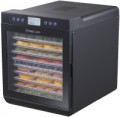Tray size
Horizontal dimensions of one dryer tray.
For round models, this paragraph usually indicates the diameter (for example, “Ø250”), for other cases — the length and width. Anyway, the information about the size allows you to estimate the total area and, accordingly, the capacity of the device. At the same time, note that a larger size affects the dimensions and weight of the structure, and also requires more heating power (ceteris paribus).
Tray height
The size of one tray of the dryer in height. In models where, instead of separate trays, a common working chamber with removable shelves is provided, the distance between two adjacent shelves is indicated.
This size primarily determines the thickness of individual pieces of vegetables, fruits, etc., which can be placed in the device. At the same time, note that the contents should not fill the tray tightly — there should be at least a couple of millimetres of space between the products and the “ceiling”. Also note that in some models, two height values can be indicated in this paragraph — for example, “15 — 25 mm”. This means that the size of the trays can be changed, adjusting them to the specifics of the situation; usually it is a choice between two standard heights (in our example — 15 mm and 25 mm).
Total capacity
The total volume of all dryer trays. The larger the volume, the more products can be loaded into the device at a time. For modern dryers, a capacity of
up to 10 L is considered relatively small,
from 11 to 15 L — medium,
from 16 to 20 L — high, and the largest models can hold
more than 20 L.
Note that if you plan to dry several different types of fruits or vegetables at the same time, it is worth considering not only the total volume of the dryer, but also the number of trays (see above).
Power consumption
Rated power consumed by the dryer during operation.
This parameter is usually selected by manufacturers depending on the volume of the dryer: the larger the device, the more power is needed to effectively heat the working chamber. At the same time, models with the same volume may differ in power consumption. In such cases, it is worth considering that a higher power reduces the heating time, but affects the price of the device.
Mesh for herbs and spices
A mesh for herbs and spices is included in the delivery set of the food dehydrator.
These meshes are characterized by a finely porous structure to prevent herbs and spices from falling through the mesh holes. They are made of silicone or stainless steel, and more rarely of bamboo. There are also variants with non-stick coating, which prevents food from sticking to the surface of the mesh.
Temperature range
The temperature range that the dryer can provide in the working chamber.
The simplest models provide only one operating temperature option, usually from 50 °C to 60 °C. More advanced devices equipped with thermostats (see above) and can have a wide range of adjustment — this is very useful, because different temperature regimes are recommended for different products. To assess the general capabilities of a particular dryer, you can use the following table of temperatures recommended for drying:
— 35...40 °C — plant stems, greens;
— 40...45 °C — bread;
— 38...42 °C (in some cases up to 45 °C) — yoghurt;
— 50...55 °C — vegetables;
— 55...60 °C — fruits;
— 65...75 °C — meat, fish.
We emphasize that these are the most general, conditional data. The specific temperature may differ from the recommended one — depending on the thickness of the slices, the specific type of food, the desired result, etc. Detailed recommendations on this matter can be found in special sources.
Keeping warm
The keep-warm function in dehydrators is designed to maintain a stable temperature after the drying process is complete. This function allows the device's interior temperature to remain at a certain level, preventing the products from cooling down, which is especially important for long-term storage. The key aspect is preventing rehydration, which helps avoid moisture that could lead to the growth of bacteria and mold.
Tray material
The material from which the complete trays of the dryer are made.
—
Plastic. Inexpensive, but at the same time very practical material. In terms of strength and overall reliability, the plastic is inferior to metal, however, during normal use of the dryer, this difference is not noticeable. In addition, if such trays are made in the form of complete compartments, their walls can be made transparent so that you can observe the contents without interrupting the process and without knocking down the temperature regime. However the transparent walls gradually become cloudy due to the low resistance of plastic to scratches — however, it takes a lot of time for this moment to become a serious inconvenience. Thus, most modern dryers use plastic trays.
—
Stainless steel. The main advantages of metal trays are strength and resistance to overheating. On the other hand, these advantages rarely turn out to be significant, and steel is more expensive than plastic. In addition, if metal trays are made in the form of separate compartments, they are opaque, and to check the condition of the products, you will have to open these compartments, lowering the temperature and disrupting the process. . For models with a rear fan (see above), this point is not relevant — they usually have a transparent door; however, such devices are not cheap. Thus, this tray material is rare nowadays — mainly among advanced dryers.

